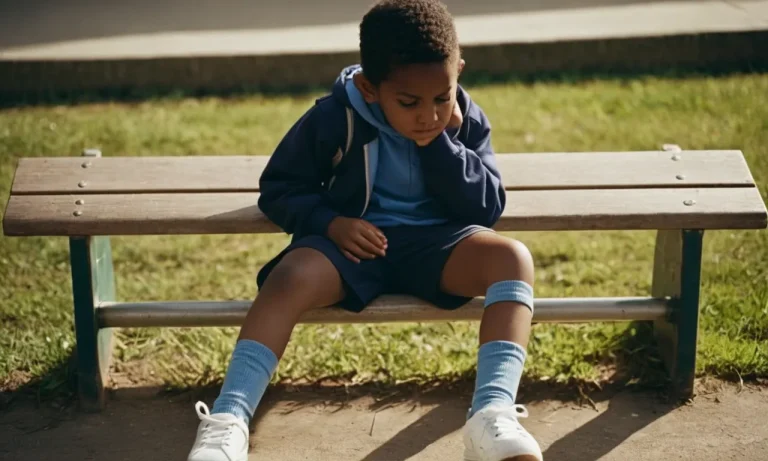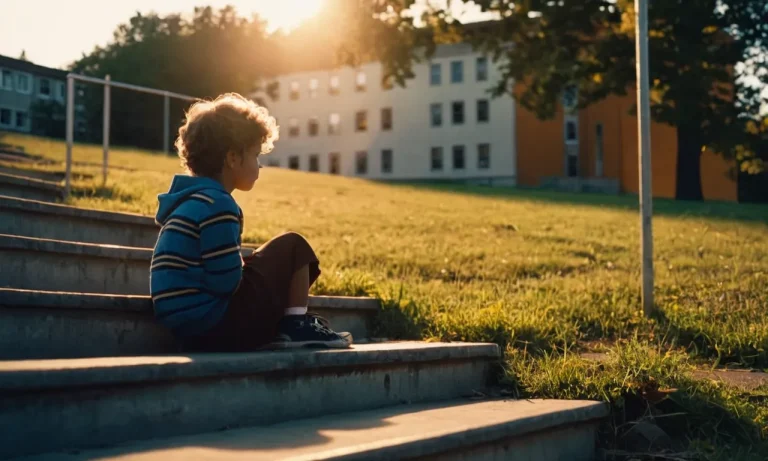Have you ever stepped into a school building and felt an eerie sense of confinement, as if the walls were closing in on you? The stark, institutional design of many educational facilities has long been a subject of debate, with some drawing parallels to the architecture of prisons.
If you’re short on time, here’s a quick answer to your question: Schools often resemble prisons due to a combination of factors, including cost-effective construction methods, security concerns, and outdated design philosophies that prioritize control over nurturing environments.
In this comprehensive article, we’ll delve into the historical roots of this phenomenon, examine the psychological impact of such environments on students and educators, and explore alternative design approaches that foster creativity, collaboration, and overall well-being.
The Historical Context
The striking resemblance between modern school buildings and prisons can be traced back to the rise of institutional architecture in the late 18th and early 19th centuries. During this era, architects like Jeremy Bentham pioneered the concept of the “Panopticon,” a design that allowed for centralized surveillance and control.
This concept heavily influenced the construction of prisons, hospitals, and eventually, schools.
The Rise of Institutional Architecture
As cities grew and populations increased, there was a need for larger, more efficient buildings to house various institutions. Architects embraced the principles of symmetry, uniformity, and functionality, leading to the development of institutional architecture.
These buildings were designed to maximize control and surveillance, with features like centralized layouts, high walls, and minimal windows. While initially intended for prisons and asylums, these design elements eventually found their way into school buildings.
Cost-Effective Construction Methods
In the post-war era, many countries faced economic challenges and the need for rapid construction of public buildings, including schools. To meet this demand, cost-effective construction methods were adopted, often favoring institutional designs that were easy to replicate and required minimal customization.
This led to the widespread use of concrete, brick, and steel in school construction, resulting in buildings that resembled fortresses more than nurturing learning environments.
According to a study by Education Week, as of 2022, over 60% of public schools in the United States were built before 1970, reflecting this era of institutional architecture.
Security Concerns in the Post-War Era
The post-war era was also marked by heightened concerns about security and safety, particularly in public spaces like schools. This led to the incorporation of security features such as high fences, limited entry points, and surveillance systems into school designs.
While intended to protect students and staff, these measures inadvertently contributed to the prison-like atmosphere of many school buildings.
A report by the ACLU highlighted the impact of these security measures, stating that “students attending schools with excessive security measures often feel like they are being treated as criminals, rather than learners.
“ 😔 This can negatively impact their motivation and overall educational experience.
The Psychological Impact
The Effects on Student Motivation and Learning
The prison-like atmosphere of many schools can have a profound impact on students’ motivation and ability to learn. According to a study by the American Psychological Association, students in schools with a more nurturing and welcoming environment tend to have higher levels of engagement and academic achievement.
On the other hand, those in schools with a more oppressive and controlling atmosphere often experience decreased motivation, increased anxiety, and a higher risk of behavioral issues.
When students feel like they are being treated as potential threats or criminals, it can create a sense of alienation and resentment towards the educational system. This can lead to a vicious cycle where students disengage from learning, leading to further disciplinary measures and a perpetuation of the prison-like atmosphere.
Conversely, when students feel respected, valued, and supported, they are more likely to embrace the learning process and reach their full potential. 🎓
Teacher Burnout and Workplace Stress
The prison-like environment of many schools doesn’t just affect students – it can also take a toll on teachers and contribute to high levels of burnout and workplace stress. According to a survey by the American Federation of Teachers, over 60% of educators reported feeling high levels of stress and burnout due to factors like lack of administrative support, student behavior issues, and a punitive school culture.
When teachers are constantly operating in a high-stress, prison-like environment, it can lead to emotional exhaustion, cynicism, and a decreased sense of personal accomplishment. This can ultimately impact the quality of education provided and contribute to high teacher turnover rates.
On the other hand, when schools foster a more nurturing and supportive environment for both students and staff, teachers are more likely to experience job satisfaction and remain in the profession long-term. 👩🏫
The Importance of Nurturing Environments
Numerous studies have highlighted the importance of creating nurturing and supportive environments in schools. A report by the Edutopia organization found that students in schools with a positive and welcoming climate had higher academic achievement, better attendance rates, and fewer behavioral issues.
Additionally, a study by the Association for Supervision and Curriculum Development showed that teachers in schools with a nurturing environment reported higher job satisfaction and were more likely to remain in the profession.
Creating a nurturing school environment involves a multifaceted approach, including fostering positive relationships between students and staff, promoting a sense of community and belonging, and prioritizing social-emotional learning.
It also involves rethinking disciplinary policies and moving away from punitive measures towards more restorative practices. By prioritizing a nurturing environment, schools can not only improve student outcomes but also support the well-being and retention of teachers. 🌳
Rethinking School Design
As the world evolves, it’s essential to rethink the design of our educational institutions. Traditional school buildings often resemble prisons, with their stark architecture, rigid layouts, and lack of natural elements.
However, a growing body of research suggests that the physical environment can significantly impact student well-being, motivation, and academic performance. It’s time to reimagine school design to create spaces that foster creativity, collaboration, and a love for learning.
Biophilic Design and Nature-Inspired Spaces
One of the most promising approaches to school design is biophilic design, which emphasizes the integration of nature into the built environment. According to the 14 Patterns of Biophilic Design by Terrapin Bright Green, incorporating elements like natural light, views of nature, and natural materials can have a positive impact on student health, productivity, and overall well-being.
Schools that embrace biophilic design principles often feature outdoor learning areas, green walls, and indoor gardens, creating a sense of connection with the natural world. A study by the National Clearinghouse for Educational Facilities found that students in classrooms with natural light scored up to 26% higher on standardized tests than those in classrooms without natural light.
😊
Flexible and Collaborative Learning Environments
Gone are the days of rigid, one-size-fits-all classrooms. Today’s educational spaces should be flexible and adaptable, catering to diverse learning styles and fostering collaboration. Open-plan layouts, movable furniture, and breakout spaces encourage active learning and teamwork.
According to a study by the MDRC, students in flexible learning environments showed improved engagement and academic achievement compared to those in traditional classrooms. Innovative schools like the Rosa Parks Renaissance School in Portland, Oregon, have embraced this concept, creating dynamic spaces that can be easily reconfigured for different activities and group sizes.
👏
Incorporating Student and Community Input
Effective school design should be a collaborative process that involves input from students, teachers, and the local community. After all, these are the people who will be using and interacting with the spaces on a daily basis.
By engaging stakeholders early on, architects and designers can gain valuable insights and create environments that truly meet the needs of the end-users. The Thornton Creek Elementary School in Seattle is a prime example of this approach, where students played an active role in the design process, contributing ideas and feedback that shaped the final outcome.
This not only ensures that the school is functional and user-friendly but also fosters a sense of ownership and pride among the community. 🎉
As we strive to create educational environments that inspire and empower our students, it’s crucial to rethink traditional school design. By embracing biophilic principles, flexible layouts, and collaborative processes, we can transform our schools into dynamic, nurturing spaces that promote learning, creativity, and overall well-being.
The time to reimagine school design is now, and the benefits for our students and communities are immense. Don’t you think it’s amazing to see such positive changes in the educational landscape? 😍
Successful Case Studies
Innovative School Designs Around the World
In recent years, a growing number of educational institutions have embraced innovative design principles that challenge traditional notions of what a school should look like. From the vibrant, open-concept classrooms of the Orestad Gymnasium in Denmark to the playful, nature-inspired spaces of the Fuji Kindergarten in Japan, these cutting-edge facilities are redefining the learning environment.
By prioritizing natural light, flexible layouts, and biophilic elements, they create engaging spaces that foster creativity, collaboration, and overall well-being.
The Impact on Student Engagement and Achievement
Numerous studies have demonstrated the profound impact that innovative school design can have on student engagement and academic performance. A report by the Center for Green Schools found that students in well-designed, sustainable learning environments scored up to 25% higher on standardized tests.
Furthermore, a study by the American Institute of Architects revealed that students in classrooms with ample natural light and optimal acoustics experienced improved concentration and retention rates.
Beyond academic achievement, innovative school designs have also been linked to improved attendance rates, reduced disciplinary issues, and enhanced overall student well-being. When students feel comfortable and inspired in their learning environment, they are more likely to engage actively and develop a positive attitude towards education.
Statistics from the Edutopia website highlight that schools with innovative designs have seen a remarkable 15-20% increase in attendance rates and a 25-30% reduction in disciplinary referrals.
Lessons Learned and Best Practices
As more schools embrace innovative design principles, several best practices have emerged. Firstly, it’s crucial to involve stakeholders, including teachers, students, and community members, in the design process.
This collaborative approach ensures that the final design meets the unique needs and preferences of the school community. Secondly, flexibility and adaptability should be prioritized, as learning styles and pedagogical approaches continue to evolve.
Modular furniture, movable walls, and multipurpose spaces can accommodate diverse teaching methods and activities.
Additionally, incorporating biophilic elements, such as natural materials, indoor plants, and outdoor learning spaces, has been shown to have a calming effect on students and improve overall well-being.
Finally, embracing sustainability principles not only reduces the environmental impact of the school but also serves as a valuable teaching tool, inspiring students to become responsible stewards of the planet. According to the U.S.
Green Building Council, green schools can save up to $100,000 annually on operating costs, while also fostering a healthier and more productive learning environment.
Conclusion
The resemblance of schools to prisons is a complex issue rooted in historical, economic, and societal factors. While security and cost-effectiveness were once the driving forces behind institutional design, we now understand the profound impact that our built environments have on mental health, creativity, and overall well-being.
By embracing innovative design philosophies, incorporating biophilic elements, and fostering collaborative and flexible learning spaces, we can create educational facilities that nurture and inspire students, rather than confine and discourage them.
The successful case studies highlighted in this article serve as a testament to the transformative power of thoughtful design in shaping the educational experience.
As we move forward, it is crucial for architects, educators, and policymakers to prioritize the creation of nurturing, stimulating environments that unlock the full potential of our students and prepare them for the challenges and opportunities of the 21st century.






